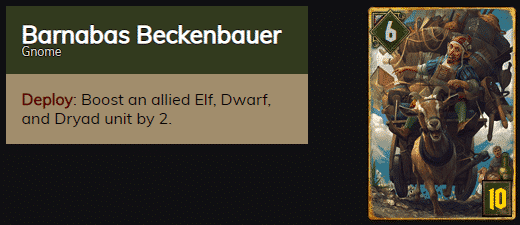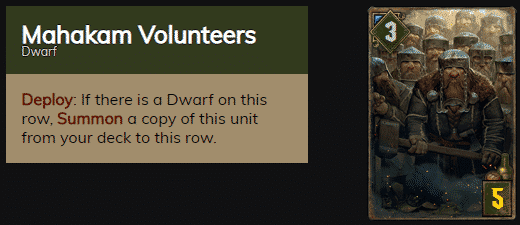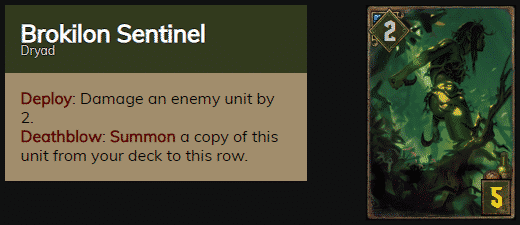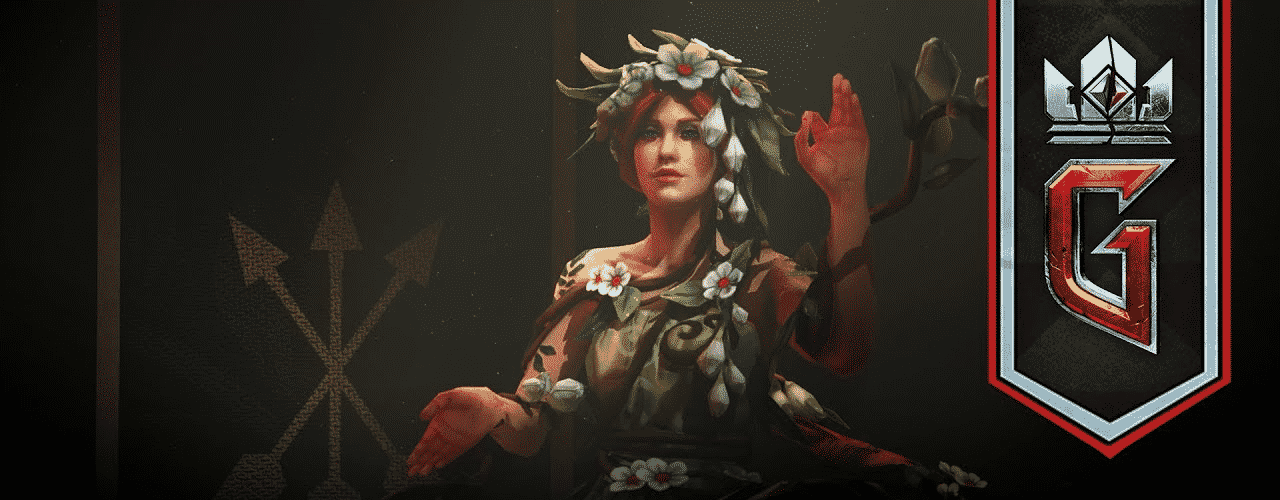Hey people, SirLoathing here. After playing exclusively various Dana Harmony builds on Pro Ladder for the last two weeks, I have concluded that with the current card pool, Dana is at a disadvantage when you could choose Eithné, Brouver, or Filavandrel. With that said, you can still climb with her and there are multiple build options that can give you a massive edge in your Gwent games. More so, despite knowing she is an underdog, I plan on continuing to ladder with her because I enjoy the leader’s playstyle.
Let our opponents underestimate us and think they can bully us in a Round 2 push. Their behavior is predictable and something great Gwent players can take advantage of. This article is going to start by classifying the diverse types of Dana decks, share what I have found to be most successful with Dana, and ultimately help you build your own Dana deck to succeed with on ladder. Winning with Dana requires customizing your deck to have surprises for your opponent. Don't just frantically copy the suggested decklists.
The Harmony Core
All Dana decks must include a core set of cards. Once you start cutting Barnabas, Fauve, Sheldon,or Sirssa you might as well play another leader. I tried multiple builds that cut one or more of these cards; at that point the advantage of playing Dana was too minimal. We will consider these cards the “Harmony Core” for Dana decks. They provide a large point bump in the round that you need them and give your leader a purpose. For those of you who haven’t been playing much since Crimson Curse’ release, let's talk about what these cards do, for those who are familiar, feel free to skip to the next section.

Fauve is a Dryad who pulls a Nature card from your deck. Water of Brokilon is a very powerful Nature card which spawns two 3 power Dryads with Harmony. That's 8 upfront points spread over three bodies that are difficult to remove all at once. This ensures that one removal spell cannot stop your engines. Astute readers might point out that Gimpy Gerwin has the ability to kill both Fledglings. Fortunately, Dana allows you to play another card after you play Fauve and Water of Brokilon. This brings your engines to 4 power immediately and gives you a colossal point gap to ride for the remainder of the round.

Sheldon Skaags has been a very threatening Scoia'tael card for months. Most Dana builds pair him with Ithlinne Aegli. Ithlinne is very expensive and although I’ll include her in most of my lists, she is a cuttable card. Sirssa on the other hand is a bargain at 8 provisions. On top of being another Harmony engine that can help you take over a round, she pairs well with Sheldon and is often worth more than her provision cost.
 Barnabas can reach 12 value for 10 provisions, provided you have all three categories on the board. Similarly to Fauve, he spreads the power across himself and three other bodies. Very provision efficient card which can also play around tall removal with ease.
Barnabas can reach 12 value for 10 provisions, provided you have all three categories on the board. Similarly to Fauve, he spreads the power across himself and three other bodies. Very provision efficient card which can also play around tall removal with ease.
Classifying Dana Strategies
We are going to look at two different ways of building Dana, what their matchups look like and how to play them properly. Both archetypes have their strengths and weaknesses. Let's jump into it by defining them.
Dana Immune
- Strong against decks that lean on damage based interactions
- Fairly even with other engine decks
- Generally plays a poor bronze core
- Lacks strong thinning options
Dana Immune includes more immune units, fewer engines and looks to make its points incredibly annoying to deal with. Because Dana’s Harmony core already includes points that are difficult to interact with, Dana Immune capitalizes on this by pairing the “wide” nature of the core with as much immune tech as possible. The deck can opt to drop its handbuff on Milva or Saesenthessis instead of Sheldon. It can even be correct to use Dwarven Agitator to handbuff Gabor over Sheldon, because Gabor’s immune option can protect your points when you don’t have the last say. Dana Immune decks have very strong carryover, can punish a push, but lack the tools to win Round 1.
Dana Engine Overload
- Stronger in a long round against pointslam and other engine decks
- Weak against decks that can remove multiple 5 power engines
- Can struggle against Round 1 tempo
- Crumbles when being bled in Round 2
Dana Engine Overload is the other direction to take your Dana deck. This strategy leans on the strong Harmony engines and tries to present more engines to your opponent than most decks can comfortably deal with. Dana Engine Overload decks prefer to run Saskia over Saesenthesis and obviously include plenty of engine based cards.
Cutting the Bronze Thinning
Let me explain why I cut the thinning package of Mahakam Volunteers and Brokilon Sentinels from all my Dana decks.


Mahakam Volunteers are too easy for most of the popular decks to leave stranded in your hand. I could see myself playing them if the meta shifts, but as long as my opponents spend every removal they can to kill Agitators and refuse to play into the melee row (to "brick" Dwarven Skirmisher) I will not suggest including Volunteers. Without a leader ability like Eithné, Brokilon Sentinels are too difficult to enable. The small reward for extra thinning with either of them is not worth the risk.
Building Dana Immune
Dana Immune attempts to “protect” its points. Our large point plays go wide, or have immunity. We will often spend our handbuffs on cards like Saesenthesis, Milva, or Gabor. The combination of Immune units with “wide” nature of the Dana Harmony core can be very difficult for an opponent to shut down without incredible over the top plays. While people are running Midrange removal based decks, Dana Immune is a strong choice. The deck does lack the tools to secure Round 1, but it doesn't need the last say. Cards like Ithlinne and Gabor punish your opponent for committing into a Round 2 bleed.
Major consideration - Dana to 9, 10 or 11
Enabling your leader to pull an 11 provision unit and running Ithlinne forces you to play multiple ‘subpar’ cards. Treant Boar is an engine card and generally dies. As such, it doesn’t really belong in a Dana Immune deck, but is the only reasonable Treant inclusion if your leader is going to pull an eleven provision card.
Crushing Trap is weak in a Round 2 bleed you often are forced into and as such is not an ideal inclusion in Dana Immune. Scoia'tael Runestone is, well, overcosted to say the least. As such, to enable your leader pulling Ithlinne requires so many subpar cards you are effectively playing as if you were a 12 provision leader. Additionally, you draw Ithlinne naturally in over half your games. With all of that said, if you are going to include Ithlinne, you certainly need to be able to have her insured.
Major consideration - The poison package
After playing many games with the poison Bronzes, I have concluded that the 5 provision cost poison Dryads are worth including in Dana Immune, but that Treant Mantis is not. Dryad Ranger also has the Harmony tag and can bait removal.
The real strength of poison is that during a Round 2 push, your opponent is forced to play their points proactively. As such, you can use poison units to protect your leader ability. If your opponent has not seen any poison cards and leads off with something like Ozzrel, the very threat of the first poison applied can usually force a pass. This leads to your leader ability remaining intact. Another benefit of the poison package is a backup Dana target.
It is clearly not ideal to pull a 5 provision card with Dana from your deck, but against some decks you can use a single turn double poison play to remove a tremendous target. The poison package certainly has some high risk high reward factors, but when playing it, I have found it to be very worth including.
Suggested decklist:
I'm not particularly happy with this version of Dana Immune, albeit I had the best results with it. The cost of Ithlinne and having Dana pull her is incredibly high. Cutting Ithlinne would allow you to remove Treant Boar in place of something like Cleaver to make your Round 1 better and give you another Agitator target. The deck relies on locks and poison to remove priority targets and punishes an opponent that pushes Round 2 with multiple forms of carryover. Your Round 1 is lacking.
I really dislike Dryad’s Caress in this decklist and support you cutting it from the deck. However, the list wants to mulligan aggressively and having Dryad’s Caress in the deck greatly lowers your chance of being forced to not spend one mulligan in fear of bricking your Fauve. Try your best to pair Dryad’s Caress with Saesenthessis.
For a long period of time I played Ida in the deck, but recently there have been less artifacts and she has not been needed; however I can see that changing. As I said earlier, it is crucial to customize your Dana list so that your opponent has some number of surprises. There are many powerful options. When tinkering with it, do not add any engines, instead change up what Midrange and removal golds you have in your toolkit.
Milaen, Cleaver, Ida, Regis: Bloodlust, Gimpy Gerwin and Geralt of Rivia are all respectable options in this meta. Try to only have one neutral gold in your deck. In general, I tend to choose Cleaver for Dana when I want a neutral gold because of his Agitator synergies. I could definitely see other options being strong techs.
Building Dana Engine Overload
Dana Engine Overload struggles to win shorter rounds, but when it gets into a long Round 3, it is incredibly powerful. Starting the round with Fauve into a board control engine like Saskia or Treant Boar can make it very difficult for your opponent to both get on the board AND deal with growing Dryads before you take over.
You have multiple periodic damage dealing units that allow you to take control of the board. Saskia, Treant Boar and Pavko each have a thick 5 starting power that is difficult to remove without help from a leader like Eithné. Getting to Round 3 with pieces of the deck still intact is the problematic part. Due to the nature of Harmony requiring you to play Scoia’tael units, you don’t have room to fit strong neutral Engine Overload payoffs such as Yennefer: Conjurer or Ocvist.
After playing a lot of games, I have concluded that the best chance you can give yourself is commiting hard into Round 1. Your 5 power engines backed up with heavy tempo plays like Cleaver can take the round. Instead of Mahakam Volunteers, I prefer running the movement engines of Dryad Matron and Dol Blathanna Sentry. Largely, this is because I am burning so many golds to try and win Round 1 that I need my 5 provision Bronzes to be the engines that can carry a long Round 3.
Suggested decklist:
The biggest issue with Dana Overload, even more so than its poor Round 1, is that you don’t have any significant finisher. Successful engine decks in the past could lean on cards like Hubert Rejk for a massive finisher that would heavily punish your opponent for spending all of their removal. Dana can utilize Sheldon, but he doesn't have as much impact as cards like Glustyworp. You just have to hope that the tempo generated by Fauve can be ridden past your opponents removal.
This deck wants the first say more than last say in Round 3. One of the easiest ways to ensure acting first in Round 3 is to generate as many points as you can as fast as possible in Round 1. You can then pass earlier and force your opponent to play multiple cards to take the round. Hands that have plenty engines, coupled with tempo from Cleaver and Milaen can comfortably do this. When you see a window your opponent can’t close, take the early pass. It is reasonable to try and fit Roach into the deck to help you with this strategy.
Final advice
I am way past my word limit, but I won't keep much longer. While this advice mostly applies to piloting Dana decks, it can help you with improving as a player in general.
Last say: For newer readers, last say refers to the person who plays the last card in Round 3. It is incredibly important to understand if you need to fight for last say in the matchup. Against most decks in the current meta, last say is irrelevant when playing any variation of Dana. This changes if your opponent likely closes with a large combo or a unit you have to respond to with your Sheldon. Try and decide within the first few cards what your priority of last say is and re-evaluate after the match if you were correct. When last say doesn’t matter, get out of Round 1 quickly.
Round length: Understand that the value of your cards changes depending upon round length. Crushing Trap has very high value in rounds above 7 cards and low value in short rounds. If the round you are currently in starts to pull longer than you feel it should be, it becomes important to play your long round cards. Many of the cards in Dana decks must be played to the board to get their full value, Milva is an excellent example. Do not be caught with Milva in your hand when your opponent is pushing you in Round 2. It is crucial to commit your long round cards early in Round 2.
Using Dana's leader ability: Probably the most difficult part of playing Dana is understanding when to use your leader. Most leaders you play against in the current meta have abilities that can be used on demand multiple times. Dana gives you one strong burst. It can be correct to go down a card in Round 2 and hold your leader. In some cases, it is correct to play leader in the middle of Round 2. I won some games by holding my leader for the final play of Round 3 to pull Fauve and Water of Brokilon for 10 points that couldn’t be interacted with.
When to push Round 2: This is more of a general advice, but is worth mentioning in regard to Dana. Sometimes as Dana, you are the player who should be pushing Round 2. Remember that the player with the weaker long Round 3 is the player who must push Round 2. Especially when you’re playing any Dana Immune deck, it can be correct to push engine decks. Alternatively, in the engine mirror, first say in Round 3 is more important than last say. As such, it is often correct to all in your opponent in Round 2 with the Dana Engine Overload deck if they decided to give up Round 1 early.
You can open Round 2 with double engine (Saskia + leader for Treant Boar) vs decks that can’t remove 5 power engines. We are currently in a meta where engine decks prefer going first in the long round over going last. The player who leads the round with a damage based Order unit like Saskia or Lyrian Arbalest is the player who can prevent their opponent from deploying their own Order based engines.
In conclusion; have fun with your Dana decks. Try to surprise your opponents. If you have a unique take on Dana, please join our discord server and let me know all about it. I would love to take it for a spin myself. https://discord.gg/uSUSJZr
This was SirLoathing and I hope that this article has provided you with the necessary tools to build your own Dana deck from the two recommended cores. Thanks for reading and good luck on the ladder!
 About SirLoathing
About SirLoathing
SirLoathing AKA Cleopatra11545 or Kevin. He has been playing Gwent since Closed Beta 2016 and every season played, he boasts a Top 100 finish. In the community, he enjoys mentoring other players and has coached a handful of folks to their first GM/Pro Ladder finish through The Lodge of Sorceresses. He does have a penchant for degenerate engine based strategies. SirLoathing looks forward to creating Gwent content with Team Leviathan that focuses on comprehensible analysis and helps any player with making their own competitive choices.


Leave a Reply